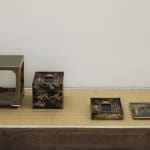Nest of Five Maki-e Inkstone Boxes with Design of Autumn Leaves
Including an inkstone, a water dropper, and a brush in each box
With two ink-stick holders
L26.6 x W18 x H23 cm
Further images
Kasane-suzuribako, literally tiered inkstone boxes, is commonly used on the occasions of waka party or incense ceremony, where a group of people gather and use ink and brush at the same time. All four sides and the top carry a design of running water and autumn foliage, imparting an autumnal atmosphere. Traditional motifs of waka poetry are favored and often borrowed in maki-e making. The motif of running water with autumn foliage recalls the famous autumn leaf viewing spot, the Tatsuta-gawa River; maki-e with such a motif is also called Tatsuta maki-e. In this case, the artisan adopts a vivid depiction rather than a stylized one. The gilded engraving water droppers with the design of maple leaves provide a sophisticated match.
This set of tiered boxes is fitted in a footed frame. The feet are entirely done in ikake-ji technique (densely sprinkled gold powder on lacquered surface) and decorated with arabesque vines painted in gold maki-e. The frame is filled with the eight-petal flower pattern all over; the chamfered edges are also done in ikake-ji technique. Interior of the both boxes and frame are applied with mura-nashiji (literally, uneven pear-skin lacquer decoration).
The artisan combines different alloys of gold, silver, and copper to create gradating tones of gold; furthermore, by applying vermilion on the apex of the leaf, he represents the different coloring stages of the leaves. The maki-e technique has been developed through the Edo period and came to its heyday in the Meiji period, when maki-e crafts were largely exported and demonstrated its excellent craftsmanship to the world. Here, the combination of the black lacquered background with the sprinkling gold creates a rhythmical contrast but a graceful world.
This set of tiered boxes is fitted in a footed frame. The feet are entirely done in ikake-ji technique (densely sprinkled gold powder on lacquered surface) and decorated with arabesque vines painted in gold maki-e. The frame is filled with the eight-petal flower pattern all over; the chamfered edges are also done in ikake-ji technique. Interior of the both boxes and frame are applied with mura-nashiji (literally, uneven pear-skin lacquer decoration).
The artisan combines different alloys of gold, silver, and copper to create gradating tones of gold; furthermore, by applying vermilion on the apex of the leaf, he represents the different coloring stages of the leaves. The maki-e technique has been developed through the Edo period and came to its heyday in the Meiji period, when maki-e crafts were largely exported and demonstrated its excellent craftsmanship to the world. Here, the combination of the black lacquered background with the sprinkling gold creates a rhythmical contrast but a graceful world.





